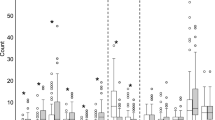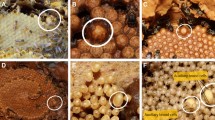Summary
About 18 percent ofLasioglossum zephyrum workers mate in the field. In the laboratory female mating receptivity varied with age and caste: 1) sixty-nine percent of bees less than 3 days old mated when kept isolated from other females, 2) in six-bee colonies all of the queens, but only 7,7 percent of their workers, mated, 3) in queen removal experiments involving 10 colonies, all the replacement queens mated (these same individuals were not receptive to mating as workers), 4) in one colony of 5 bees, consecutive queen removal showed that each of the four bees identified as the queen mated, while none of the remaining workers did so. The results indicate that queen inhibition governs behavior of the workers even outside the nest. The inhibition may involve more than differences in ovarian size.
Zusammenfassung
Ungefähr 18% der Arbeiterinnen vonLasioglossum zephyrum werden unter natürlichen Freilandbedingungen begattet. In der Gefangenschaft variiert die Bereitschaft der Weibchen zur Begattung mit dem Alter und dem Kastenzustand: 1) Von anderen Weibchen isolierte Weibchen paarten sich zu 69% innerhalb von drei Tagen nach dem Schlüpfen. 2) In Nestgruppen von je sechs Bienen paarten sich alle Königinnen, jedoch nur 7,7 % aller Arbeiterinnen. 3) Nach künstlicher Entfernung der Königin verpaarten sich die Ersatzköniginnen in allen von zehn Fällen. Diese Ersatzköniginnen waren alle vorher in Gegenwart der alten Königin unverpaart. 4) In einer Kolonie von fünf Bienen paarten sich alle drei Ersatzköniginnen nachdem der Reihe nach die jeweilige Königin entfernt worden war. Gleichzeitig wurden keine der jeweiligen Restarbeiterinen begattet. Diese Ergebnisse zeigen an, dass die Königin die Paarungsbeitschaft der Arbeiterinnen auch ausserhalb des Nestes inhibiert. Es erscheint möglich, dass sich Inhibition durch eine Königin nicht nur auf die Grösse der Ovarien von Arbeiterinnen auswirkt.
Similar content being viewed by others
References
Alexander R.D., 1974. — The evolution of social behavior.Annu.Rev. Ecol. Syst., 5, 325–383.
Barrows E.M., 1975. — Mating behavior in halictine bees.Ph. D. dissertation, University of Kansas.
Batra S.W.T., 1966. — The life cycle and behavior of the primitively social bee,Lasioglossum zephyrum (Halictidæ).Univ. Kansas Sci. Bull., 46, 359–423.
Brothers D.J., Michener C.D., 1974. — Interactions in colonies of primitively social bees. III. Ethometry of division of labor inLasioglossum zephyrum (Hymenoptera: Halictidæ).J. Comp. Physiol., 90, 129–168.
Buckle G.R., in prep. — Caste differences and nestmate interactions inLasioglossum zephyrum.
Crozier R.H., 1979. — The genetics of sociality.In The social insects, Vol. 1, Hermann (H. R.),Academic Press, New York, 223–286.
Greenberg L., in prep. —Year-round rearing of a sweat bee.
Hamilton W.D., 1964. — The genetical evolution of social behaviour, I and II.J. Theor. Biol., 7, 1–52. 1972. Altruism and related phenomena, mainly in social insects.Annu. Rev. Ecol. Syst., 3, 193–232.
Lin N., Michener C.D.,1972. — Evolution of sociality in insects.Quart. Rev. Biol., 47, 131–159.
Litte M., 1977. — Aspects of the social biology of the beeHalictus ligatus in New York State.Insectes Soc., 24, 9–36.
Michener C.D., 1974. — The social behavior of the bees.Harvard Univ. Press, Cambridge, (Mass.).
Michener C.D., Wille A., 1961. — The bionomics of a primitively social bee,Lasioglossum inconspicuum.Univ. Kansas Sci. Bull., 42, 1123–1202.
Michener C.D., Brothers D.J., 1971. — A simplified observation nest for burrowing bees.J. Kansas Entomol. Soc., 44, 236–239.
Michener C.D., Brothers D.J.,1974. — Were workers of eusocial hymenoptera initially altruistic or oppressed?Proc. Nat. Acad. Sci. U.S.A., 71, 671–674.
Trivers R.L., Hare H., 1976. — Haplodiploidy and the evolution of the social insects.Science, 191, 249–263.
West-Eberhard M.J., 1975. — The evolution of social behavior by kin selection.Quart. Rev. Biol., 50, 1–33.
West-Eberhard M.J., 1978. — Polygyny and the evolution of social behavior in wasps.J. Kansas Entomol. Soc., 51, 832–856.
Wilson E.O., 1975. — Sociobiology.Harvard Univ. Press., Cambridge, (Mass.).
Author information
Authors and Affiliations
Rights and permissions
About this article
Cite this article
Greenberg, L., Buckle, G.R. Inhibition of worker mating by queens in a sweat bee,Lasioglossum zephyrum . Ins. Soc 28, 347–352 (1981). https://doi.org/10.1007/BF02224192
Received:
Accepted:
Issue Date:
DOI: https://doi.org/10.1007/BF02224192




